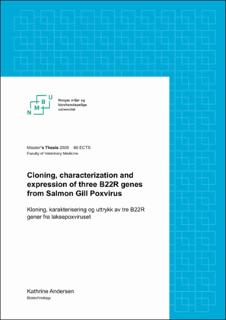| dc.contributor.advisor | Dahle, Maria K | |
| dc.contributor.advisor | Markussen, Turhan | |
| dc.contributor.advisor | Gjessing, Mona C | |
| dc.contributor.author | Andersen, Kathrine | |
| dc.date.accessioned | 2021-01-01T21:52:53Z | |
| dc.date.available | 2021-01-01T21:52:53Z | |
| dc.date.issued | 2020 | |
| dc.identifier.uri | https://hdl.handle.net/11250/2721172 | |
| dc.description.abstract | Salmon Gill Poxvirus Disease (SGPVD) is a severe viral disease that can cause acute mortality in farmed Atlantic salmon. The disease is caused by SGPV that is a large DNA virus. The virus infects gill epithelial cells and causes cell death and destruction of the gill respiratory surface in the acute phase. Due to the complex gill disease often seen associated with SGPV, it has been proposed that SGPV modulates the mucosal immune system, which then allows invasion of other pathogens.
The SGPV genome was characterized in 2015 and shown to encode over 200 genes. Among these are three paralogues of a large gene from the deadly human variola virus, called B22R. The B22R family of proteins are reported to inhibit T-lymphocyte function in the host and thereby promote viral virulence. The B22R-like genes in SGPV show a higher degree of sequence variation between isolates compared to the full genome. It is therefore hypothesized that these genes could play a role in the difference between severe and mild disease.
The three B22R-like SGPV genes (B22R1, B22R2 and B22R3) from two SGPV isolates; one originating from a severe disease outbreak in a Norwegian fish farm in 2019, and another isolated from wild Norwegian salmon without clinical disease, were cloned into expression vectors. A FLAG-tag encoding sequence was included in all constructs so that each B22R paralogue was expressed as a fusion protein with the tag fused to its C-terminal end. For B22R3, an N-terminal tagged variant was also constructed. Atlantic salmon gill epithelial cells (ASG-10) and epithelioma papulosum cyprini (EPC) cells (from carp) were transfected with the expression vectors. The presence and subcellular localization of the different proteins was explored using a fluorescent anti-FLAG antibody together with selected markers for intracellular compartments and structures. The B22R protein sequences were also investigated using several bioinformatics (in silico) tools to predict functional and structural properties. Expression of the B22R-like genes were also monitored by RT-qPCR in gill samples from an SGPV-infection experiment. This is the first step towards constructing targeted functional assays for SGPV B22R variants, and further explore their functional roles with potential links to virulence. | en_US |
| dc.description.abstract | Salmon Gill Poxvirus Disease (SGPVD), eller laksepox er en alvorlig virussykdom som kan føre til akutt dødelighet i lakseoppdrettsnæringen. Sykdommen forårsakes av laksepoxvirus eller SGPV er et stort DNA virus. Viruset infiserer de respiratoriske overflatecellene på gjellene og fører til at de dør og faller av under den akutte infeksjonsfasen. Laksepoxvirus blir noen ganger påvist i sammenheng med kompleks gjellesykdom og det har det blitt foreslått at SGPV modulerer slimhinneimmuniteten slik at barrierefunksjonen svekkes og lettere angripes av andre patogener.
Genomet til SGPV ble karakterisert i 2015, og viser seg å inneholde over 200 gener. Blant disse er det tre paraloger av et stort gen fra det dødelige, humanpatogene variolaviruset, kalt B22R. Det har blitt rapportert at proteinene i B22R-familien hemmer funksjoner hos Tlymfocytter i verten, og dermed fremmer virulens. De B22R-liknende genene i SGPV viser seg å ha en høyere sekvensvariasjon mellom isolater sammenliknet med resten av genomet. Hypotesen er at disse genene kan spille en rolle i forskjellen mellom alvorlig og mild sykdom.
De tre B22R-liknende genene (B22R1, B22R2 og B22R3) fra to SGPV isolater; et fra et alvorlig sykdomsutbrudd i et norsk fiskeoppdrettsanlegg i 2019, og et annet fra norsk villfisk uten klinisk sykdom, ble klonet inn i ekspresjonsvektorer. En FLAG-tag kodende sekvens ble inkludert i alle konstruktene, slik at hver B22R paralog var uttrykt som et fusjonsprotein med merking i proteinets C-terminale ende. En N-terminal merket variant ble også konstruert for B22R3. Gjelleepitelceller fra atlantisk laks (ASG-10) og epithelioma papulosum cyprini (EPC) celler (karpeceller) ble transfektert med ekspresjonsvektorene. Tilstedeværelse og subcellulær lokalisasjon av de tre ulike proteinene ble undersøkt ved å bruke et fluorescerende antistoff mot FLAG-taggen sammen med utvalgte markører for intracellulære strukturer. B22R proteinsekvensene ble også undersøkt ved å bruke ulike bioinformatiske (in silico) verktøy for å predikere funksjonelle og strukturelle egenskaper. Uttrykk av de tre B22Rliknende genene ble også undersøkt med RT-qPCR på gjelleprøver fra et oppdrettsanlegg og et smitteforsøk med SGPV-smitte. Dette er første steg mot å konstruere en målrettet funksjonell analyse av B22R varianter for SGPV, og videre utforske proteinenes funksjonelle roller og potensielle kobling til virulens. | en_US |
| dc.language.iso | eng | en_US |
| dc.publisher | Norwegian University of Life Sciences, Ås | en_US |
| dc.rights | Attribution-NonCommercial-NoDerivatives 4.0 Internasjonal | * |
| dc.rights.uri | http://creativecommons.org/licenses/by-nc-nd/4.0/deed.no | * |
| dc.title | Cloning, characterization and expression of three B22R genes from Salmon Gill Poxvirus | en_US |
| dc.title.alternative | Kloning, karakterisering og uttrykk av tre B22R gener fra laksepoxviruset | en_US |
| dc.type | Master thesis | en_US |
| dc.description.localcode | M-BIOTEK | en_US |

